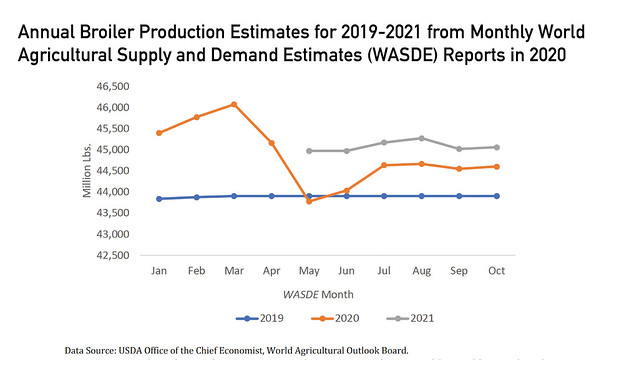Oct. 16, 2020
Poultry industry sees modest recovery, but faces uphill slog through 2021
By Mary Hightower
U of A System Division of Agriculture
Fast facts
- WASDE poultry analysis: https://bit.ly/3k4XmXr
- Poultry industry could see slowest growth since 2012-2013
(431 words)
Download MS Word version here
(Newsrooms: Graph of broiler production estimates — https://flic.kr/p/2jW4DPB)
FAYETTEVILLE, Ark. — The poultry industry, battered on multiple fronts by the COVID pandemic, is making modest gains, but recovery into 2021 may be its slowest in nearly a decade.
In looking at the Oct.14 World Agricultural Supply and Demand Estimates Projections for the Broiler Industry, economist John Anderson noted that there were more complex factors at play than simple supply and demand.
Anderson is head of the agricultural economics and agribusiness department for the University of Arkansas System Division of Agriculture and the Dale Bumpers College of Agricultural Food and Life Sciences. He has been providing pandemic-related analyses of the economy since March.
“These factors include the supply-side effects of changes in production and processing operations in response to COVID-19 as well as demand-side effects related to the economic disruptions resulting from COVID-19,” he said, adding that these included “continued sluggish demand from the food service sector.”
Anderson said the price impacts of the pandemic were probably even more significant for the broiler industry than the production disruptions. In 2019, broiler wholesale prices averaged 88.6 cents per pound according to the WASDE report.
“At the beginning of 2020, expectations were for prices to slip around 2 percent in the face of increasing production, he said. “As the pandemic unfolded, though, price expectations deteriorated dramatically. The latest WASDE report projects a 2020 average broiler price of 70.8 cents per pound, a decline of about 20 percent compared to the prior year.”
On a positive note, broiler production has rebounded since June, and Anderson said expectations for 2020 production have stabilized at about 1.5 percent above last year’s production.
“It is remarkable that the industry appears set to manage a modest increase in production given the magnitude of the 2020 market shock,” he said. “Still, current expectations are over 3 percent lower than in March, illustrating the significant negative impact of the pandemic on the supply side of the market.”
Current expectations as reflected in October WASDE projections are for a relatively slow recovery for the sector. The current projection for 2021 production is 45.06 billion pounds, which is up 1 percent from 2020, and an average wholesale price of 79 cents per pound, up 12 percent from last year.
“This works out to an expected wholesale value of production of $35.6 billion: a significant recovery from 2020 but still 8.5 percent below 2019,” he said.
“If current projections hold, 2020-2021will witness the slowest two-year growth in broiler production since 2012-2013, when the industry faced record-breaking corn prices,” Anderson said.
Find Anderson’s WASDE analysis here: https://bit.ly/3k4XmXr.
To learn about extension and research programs in Arkansas, visit https://uada.edu/
Follow us on Twitter at @AgInArk, @uaex_edu or @ArkAgResearch.
About the Division of Agriculture
The University of Arkansas System Division of Agriculture’s mission is to strengthen agriculture, communities, and families by connecting trusted research to the adoption of best practices. Through the Agricultural Experiment Station and the Cooperative Extension Service, the Division of Agriculture conducts research and extension work within the nation’s historic land grant education system.
The Division of Agriculture is one of 20 entities within the University of Arkansas System. It has offices in all 75 counties in Arkansas and faculty on five system campuses.
Pursuant to 7 CFR § 15.3, the University of Arkansas System Division of Agriculture offers all its Extension and Research programs and services (including employment) without regard to race, color, sex, national origin, religion, age, disability, marital or veteran status, genetic information, sexual preference, pregnancy or any other legally protected status, and is an equal opportunity institution.
Media Contact: Mary Hightower
Chief Communications Officer
University of Arkansas System Division of Agriculture
mhightower@uada.edu
501-671-2006
